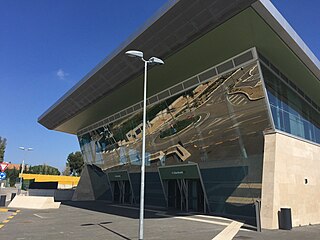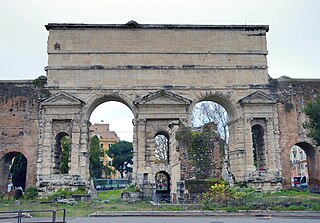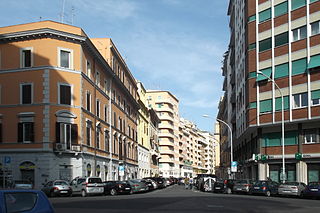
Parioli is the 2nd quartiere of Rome, identified by the initials Q. II.

Prima Porta is the 58th zona of Rome, identified by the initials Z. LVIII. The name Prima Porta came from an arch of the aqueduct that brought water to the Villa of Livia, which formed over Via Flaminia a sort of gateway which travellers saw as the first indication of having reached Rome (Piperno).

Ostia Antica is the 35th zona of Rome, Italy, four kilometers away from the coast. It is identified by the initials Z. XXXV and it is distinct from Ostia. Ostia Antica belongs to Municipio X.

Labaro is the 57th zona of Rome, identified by the initials Z. LVII. It is located 11 kilometres north of the city center, along the Via Flaminia, just outside the Grande Raccordo Anulare.

Cesano is the 52nd zona of Rome, Italy, identified by the initials Z. LII. It takes its name from the small medieval village of Cesano di Roma, on the Via Cassia, which is located within the Municipio XV, 27 km from Rome proper.

Settecamini is the 6th zona of Rome, identified by the initials Z. VI.. Settecamini is also the name of the urban zone 5L, within the Municipio V of Rome.

Ponte Galeria is the 41st zona of Rome, Italy, identified by the initials Z. XLI. Geographically it was part of Agro Romano. The zone belongs to the Municipio XI.

The Roma–Giardinetti railway is a narrow-gauge street running tram-train railway in Rome, Italy. It connects Laziali with Giardinetti to the east just past the Grande Raccordo Anulare, Rome's orbital motorway. It is run by ATAC, the company responsible for public transportation in the city, which also operates the Rome Metro.

Val Melaina is the 1st zona of Rome, identified by the initials Z. I, lying north of the city centre and covering an area of 6.2447 km².

La Storta is the 51st zona of the Italian capital city, Rome. It is identified by the initials Z. LI and falls within the boundaries of Municipio XV.

Giuliano-Dalmata is the 31st quartiere of Rome, identified by the initials Q. XXXI. Its name refers to the Julian, Istrian and Dalmatian refugees that settled there in the postwar period.

Giardinetti is an underground station of Line C of the Rome Metro. It is located along the Via Casilina, at the intersection with Via degli Orafi and Via della Fattoria di Torrenova, in the Roman district of Giardinetti, near the Grande Raccordo Anulare. Construction of the station started in 2007 and it was opened on 9 November 2014. The homonymous terminus of the Rome–Giardinetti railway line was relocated within 500 metres from the Metro station.

Torrenova is a surface station of Line C of the Rome Metro. It is located in Via Casilina, serving the Roman districts of Torre Angela, Tor Vergata and Giardinetti. It's the only above-ground stop of Line C which retained the original architecture of the historic train station on the Rome–Pantano railway line. The old train station was temporarily closed down in 2008 for restoration and modernisation works; it re-opened on 9 November 2014 as part of the new Metro line.

Roma Laziali is a railway station in Rome located next to the southern façade of Termini station. It is the western terminus of the Rome-Giardinetti railway.

Tor Cervara is the 7th zona of the Italian capital Rome, identified by the initials Z. VII. It belongs to the Municipio IV and has 13,975 inhabitants (2016). It is located in the east of the city, within the Grande Raccordo Anulare, and has an area of 5.9000 km2.

Municipio Roma VII is the seventh administrative subdivision of the Municipality of Rome (Italy).

Castel Giubileo is the second Zone of Rome in the Ager Romanus, identified as Z. II.

Prenestino-Labicano is the 7th quartiere of Rome (Italy), identified by the initials Q. VII. The name derives from the ancient roads Via Prenestina and Via Labicana, today the initial stretch of Via Casilina. It belongs to the Municipio V and Municipio VII.

Tuscolano is the 8th quartiere of Rome (Italy), identified by the initials Q. VIII. The name derives from the ancient road Via Tuscolana. It belongs to the Municipio V and Municipio VII.

Aurelio is the 13th quartiere of Rome (Italy), identified by the initials Q. XIII. It belongs to the Municipio XIII and Municipio XIV.






















